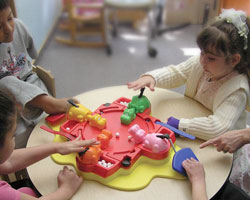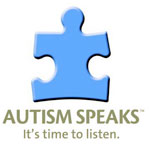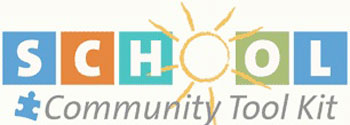Spring 2011
A publication of the West Virginia Assistive Technology System
Articles: [Apple's Accessible iPad 2] [Exchange Your Assistive Technology!] [Try It Out!] [An Inclusive Music Classroom]
Apple's Accessible iPad 2

Apple's iPad hit the market last year and we are only beginning to see how this new product could help students with disabilities. The iPad 2 is currently available at a price starting at approximately $499 and is both small and light, weighing only 1.5 pounds. It is loaded with many accessible features already installed with countless other iPad applications available upon additional purchase. The following are a few of the standard accessibility features that come with the iPad 2 free of charge:
- VoiceOver: Touch the screen to hear an items description. The VoiceOver program speaks 21 languages and works with all of the programs in the iPad.
- Mono Audio: This feature lets people with limited hearing in one ear tap a checkbox to pan right and left channel audio into both headphones, so they can hear both channels in either ear.
- Zoom: Any application can be magnified up to five times the normal size. This feature works on all pages and with all applications.
- Closed Captioning: The device can display closed captioning for the deaf and hard of hearing when they are playing movies and podcasts that support it.
- White on Black: The display can be changed to white on black if the user needs higher contrast. This feature can be used on any page or with any application.
The iPad provides applications that may be useful to students with either a visual or hearing disability, individuals with a learning disability or for teaching communication and social skills.
A few considerations should be made before buying an iPad. First, in order to make this a usable device, access to the internet is necessary to download applications. If the user has used an iPhone or iPod Touch, using the iPad should be simple. If the user has not used these devices, a tutorial and a fair amount of patience may be necessary to get the device operational.
Second, while the iPad is only 1.5 pounds, that weight can still be heavy to a student with limited mobility or muscle tone in the hand, wrist or arm area. There are devices for mounting the iPad that could help such individuals.
WVATS has an iPad and offers demonstrations on the device. The iPad is also available for loan to professionals only. For more information or to schedule a demonstration, call WVATS at 800-841-8436.
Exchange Your Assistive Technology!

The WVATS Virtual Loan Library System is not only a free resource for you to borrow devices from us, but a resource for you and various other professionals around the state to post and obtain devices from each other. If you have a device that is no longer in use and would like to give it away or sell it, you may post it on our website under the "Items Tab" by clicking "Item Add". If you have a need for a device and cannot find what you are looking for from WVATS, post a small comment about your need on the website under "Want Add" in the items tab and see if any other subscribers have a related device they can exchange with you. Let's get these devices out of our closets and put them to use!
For more information, visit our online virtual loan library at vll.cedwvu.org or call us at 800-841-8436.
Try it Out!
The following items from the WVATS Loan Library are new and available for 30 day trial periods. For more information or to check an item out, visit the WVATS online Loan library and Exchange System at vll.cedwvu.org or call us at the Center for Excellence in Disabilities at 800-841-8436.
Adapted Hungry Hungry Hippo Game

This adapted version of the classic Hungry Hungry Hippo Game has been made more accessible to children for easy activation. This game is designed to aid children with limited mobility or fine motor skills to more easily activate the lever. This version includes two stick switches to release the balls from their holding compartment and two paddles attached to the hippos to help gobble up the balls. For more information, please visit www.enablingdevices.com or call 800-832-8697.
Time Tracker Pediatric Timer
![]()
The time tracker is a visual timer and clock that helps children to track the progression of time. This device may be useful in a variety of time management situations such as setting time limits or transitioning smoothly between activities, helping individuals or groups of students track their progression, or giving time outs in the classroom. This device features lighted green, yellow and red sections that flash in a chronological order as time runs out. The yellow helps to serve as a warning to students to prepare to stop or change activities and the red light indicates when the time is up. This timer also includes six different sound effects that can be played as the color changes and time can programed from seconds to hours. For more information, please call 800-827-8283 or visit www.rehabmart.com.
An Inclusive Music Classroom
From painting a picture to playing an instrument, including various art forms in the classroom will allow students to access a rich medium for expression and creativity. Music can be found in many classrooms; from elementary school to high school, both general classes and specialized such as band or chorus.
According to the American Music Therapy Association (AMTA) factsheet, "Music therapy is a particularly important intervention for children with special needs to engage and foster their capacity for flexibility, creativity, variability, and tolerance of change, in order to balance the more structured and behaviorally driven education required in school settings." The AMTA also states that the outcomes of using music therapy can increase socialization, attention, self-expression, auditory processing, improved behavior, receptive/ expressive language and sensory motor skills.
While there are many possible benefits to using the arts in the classroom, teachers may wonder how to provide them in an accessible manner. To make music accessible in the classroom, consider the following:
For students with hearing loss
- Increase the bass and consider setting the speakers on or into the ground so that students may better sense the vibrations emitted from the sound.
- Seat students next to the speakers or subwoofers.
- Sing and carefully articulate words with students.
- Conducting can provide a visual representation of the music.
- Use action songs and fingerplays (like Itsy-Bitsy Spider).
- Provide sheet music or lyrics to students
- Using classroom manipulatives to help students follow along to the song.
- When using band instruments, consider the bass drum or a reed instrument such as a clarinet or saxophone- instruments in which the vibrations can be easily felt.
For students with vision loss
- Have students move and express the song or clap to the beat.
- Make lyrics or sheet music accessible by
- Using Braille sheet music or swell/tactile paper to create sheet music.
- Using the copy machine to increase the font size of the music or lyrics.
For students with a cognitive disability
- Highlighting each line of music in a different color or highlight similar passages in a similar color
- Color code the notes. For example:
- Label all "A"s as red, "B"s Blue, "C"s Orange, "D"s Green, etc.
- On a piano, assign a color for notes assigned to the left or right hand.
- Be open to repeating an instruction for those who have limited attention spans.
For individuals with a mobility impairment
- Use modifications or create assistive technology for instruments. This includes instrument holders, grasping aids, and Velcro or clothes pens for steadying music.
- When using band instruments, consider those with few keys (such as the trumpet or baritone) or percussion with adaptations. For other instruments, try using straps, switches and extra cushioning on levers or keys.
Source:
American Music Therapy Associations. Special education: music therapy research and evidencebased practice support.
Retrieved from http://www.musictherapy.org/factsheets/bib_specialed.pdf
Autism Speaks FREE School Community Took Kit

Autism Speaks has put together a series of tool kits for families and educators to use as resources when working with individuals with autism. The School Community Tool Kit is designed to assist members of the school community in understanding and supporting students with autism. This tool kit provides valuable information and resources that can be employed by special education and administrative staff in their efforts to plan for and support students in general education environments and involvement in the school community as a whole. The information assists in staff training efforts, offers an introduction to autism and highlights specific strategies that have been found to be helpful.

The School Community Tool Kit has a series of modules to assist educators, supporting staff, and peers in understanding and preparing for their encounters with children with autism. The General Strategies for Intervention module discusses using a team approach in working with children with autism, how to support communication, improve social interaction and development, and strategies to promote socially appropriate behavior. The tool kit also includes a variety of links to other resources that educators may find helpful.
Other tool kits offered include the Transition Tool Kit, Dental Guide, Haircutting Training Guide, 100 Day Kit, and the Asperger Syndrome and High Functioning Autism Tool Kit. The School Community Took Kit and other tool kits are available for free download at www.autismspeaks.org.
WVATS Teacher Tech
Contributing Writer: Jessi Wright
Editorial Committee: Melina Danko, Mary Slabinski, Sarah Ott, Daria Jones and Bev Sheets
Layout: Brian Pickens
WVATS
Center for Excellence in Disabilities
West Virginia University
959 Hartman Run Road
Morgantown, WV 26505
Voice : 304-293-4692
Hotline: 800-841-8436
TTY: 800-518-1448
All printed materials are available in braille, electronic format, cassette tape and large print.
WVATS is funded by the US Department of Education, Rehabilitation Services Administration Contract# H224A100047
WVU is an Affirmative Action/Equal Opportunity Institution

